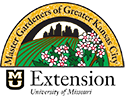Hotline: 816.833.TREE (8733)

-
Oct
25
Organic Does Not Mean Pesticide-free
By Dennis L. Patton, M.S., County Horticulture Agent, K-State Research and Extension/Johnson County I was flying home after attending a recent conference. Seated next to me was a very pleasant person. We struck up a typical causal airplane conversation. Where...
Continue Reading → -
Oct
24
Fall Colors of Trees
Part of the allure of fall foliage is color variation. There are trees that turn red, purple, yellow, orange and brown. Specific plant pigments determine individual colors. Foliage derives its normal green color from chlorophyll, the substance that captures...
Continue Reading → -
Oct
8
Fall Planting of Asparagus and Rhubarb
We sometimes receive questions as to whether asparagus or rhubarb can be moved in the fall. Though these crops are traditionally transplanted in the spring (mid-March to mid-April), a fall move can be successful. Wait until the top has...
Continue Reading → -
Oct
4
Gardeners’ Gathering Thursday, August 17, 2017 “Gardening for Bees and Butterflies”
The Master Gardeners of Greater Kansas City present “Gardening for Bees and Butterflies “ by our special guest, Heather Holm. She is the author of “Pollinators of Native Plants” and “ BEES: An identification and Native Plan Forage Guide”. There...
Continue Reading → -
Sep
7
Harvesting and Roasting Sunflower Seed
Sunflowers are usually ready to be harvested beginning in mid-September and into October. Seed heads can ripen on the plant, but they will need protection from birds. Try covering the heads with a paper sack or cheesecloth once the petals...
Continue Reading → -
Aug
26
September Gardening Calendar
Ornamentals Weeks 1-4: Continue planting evergreens now. Weeks 1-3: Cuttings of annuals can be taken now to provide vigorous plants for overwintering. Weeks 1-3: Herbs such as parsley, rosemary, chives, thyme and marjoram can be dug from the garden and...
Continue Reading → -
Aug
14
Pear Harvest
Most pear cultivars should not be allowed to ripen on the tree. They should be picked while still firm and ripened after harvest. Tree-ripened fruits are often of poor quality because of the development of grit cells and the browning...
Continue Reading → -
Aug
7
Fertilize Strawberries
An August application of nitrogen on spring-bearing strawberries is important in order to increase the number of strawberries produced next spring. Plenty of daylight and warm temperatures during June, July and August promotes the growth of new runner, or...
Continue Reading → -
Aug
7
-
Jul
28
Is My Lawn Still Alive?
Normally, a healthy lawn can stay dormant for a good 5 weeks and still recover. After the five weeks are up, it is important to keep the crown hydrated because if the crown dies, the plant dies. The recommendations...
Continue Reading →









